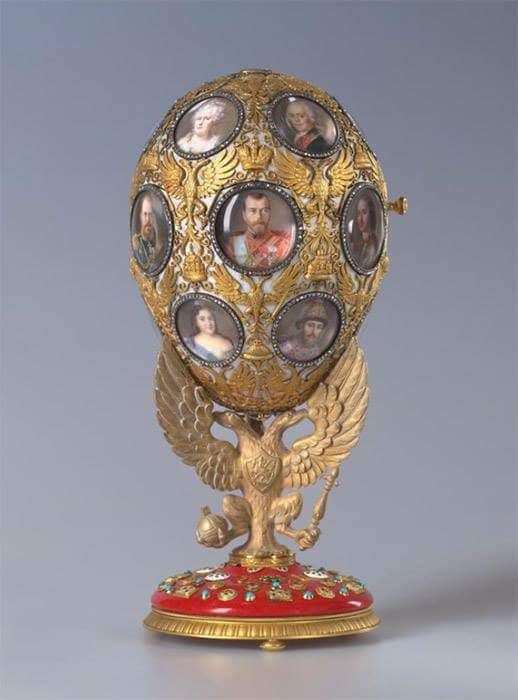 EASTER EGG "300TH ANNIVERSARY OF ROMANOVS"
EASTER EGG "300TH ANNIVERSARY OF ROMANOVS"
On February 21, 1913, all Russia celebrated the 300th anniversary of the Romanovs' reign - three centuries before that, the sixteen-year-old boyar Mikhail Feodorovich Romanov, who had become the founder of the new dynasty, was called to the throne of Moscow. The anniversary was celebrated with great solemnity. The court jeweler Carl Faberge, who often captured important events from the life of the Russian Empire in his Easter masterpieces, dedicated the egg of 1913 to the anniversary of the House of Romanovs. The most important political issue required a particularly solemn artistic embodiment. It is unlikely that there will be another monument from the brilliant series of imperial Easter eggs, so full of elements of state symbols.
The basis for the egg was a miniature copy of the State shield, which was part of the royal regalia from the end of the XVII century and stored in the Museums of the Moscow Kremlin. The shield itself is made of wood, covered with red velvet and decorated with decorative lining of jade and rock crystal, encrusted with precious stones and enamels. Faberge masters made a copy of a shield of bright red purple glass. Sparks of internal inclusions in glass well transmit the iridescent surface of red velvet. The stand for the egg, made of gilded silver, looks like a three-sided coat of arms with a scepter and power in its paws. The top and bottom of the egg are decorated with large flat diamonds, below them on the silver foil the dates "1613" and "1913" (at the top) and the monogram of the empress (below) are inscribed in black. The decoration of the egg itself strikes with special magnificence: its golden shell is decorated with white iridescent enamel on guilloche and is covered with a golden chased grid with relief images of royal crowns and two-headed eagles, each detail of which is distinguished by its exceptional fineness and purity of execution. The jewelers of G. Wigstrem's workshop brilliantly used a decorative technique called specialists cagework - a frame, a grid, a grille. But, of course, the main decoration of the Easter masterpiece of 1913 is the eighteen miniature portraits of all the reigning representatives of the House of Romanovs. They are painted in watercolor on the bone and placed under the convex plates of rock crystal. The framework of the portraits is made of small diamonds - "monarch stones" framing images of the highest persons in many works of Faberge. On the Easter egg, the images of the dynasty representatives are placed in chronological order, the masters departed from it only once: a portrait of Nicholas II lies between the portraits of his father Alexander III and Peter I.
Miniature portraits of monarchs are distinguished by the sophistication of technical execution, the perfection and completeness of making, scrupulousness in the depiction of costumes and accessories. The author of these miniatures was Vasily Zuev, a well-known Petersburg miniaturist who collaborated with Faberge.
The surprise of the egg "The Three Hundredth Anniversary of the Romanov House" clearly illustrates the idea of expanding and strengthening the Russian State by crowned representatives of the ruling dynasty. Inside the egg is placed a rotating globe made of blued steel, the deep blue color of which conveys the coloration of the seas and oceans. Continents of colored gold are strengthened on the surface of the globe, and the image of the Northern Hemisphere is twice given. On one you can see the territory of Russia within the borders of 1613, and on the other - within the borders of 1913. The surprise of this Easter gift is a visible and original embodiment of the idea that during the three hundred years of the Romanov dynasty the Moscow State has become a vast Russian empire stretching on vast expanses. Egg, dedicated to the anniversary of the Romanov dynasty, is a kind of reified political manifesto of the epoch when the Russian Empire was among the first world powers.
Hi! I am a robot. I just upvoted you! I found similar content that readers might be interested in:
https://www.facebook.com/oldfashionedbeauty
postingan anda sudah di muat di halaman @cheetah
bisa di cek